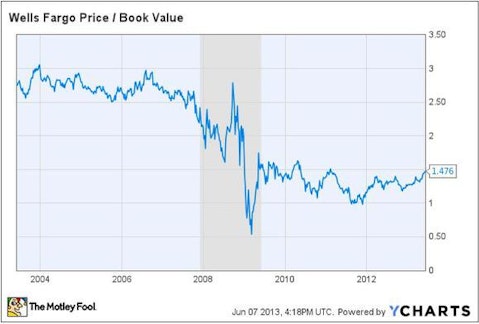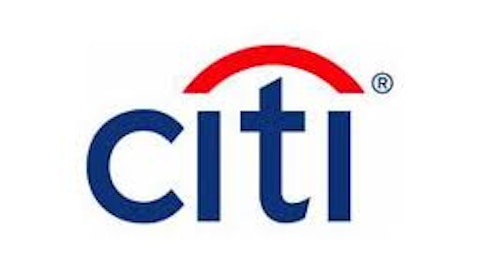
Simplicity and quality
Buffett believes in the power of simplicity, and Wells Fargo & Co (NYSE:WFC) is unquestioningly the high quality play among big U.S. banks due to its straightforward business model and superior risk management policies. While competitors like Bank of America Corp (NYSE:BAC) and Citigroup Inc (NYSE:C) were exposing themselves to toxic assets and complex derivatives during the credit bubble, Wells Fargo was simply focused on what it does best; loaning money to deserving clients.
Book value is traditionally used to evaluate financial companies, since their assets and liabilities are mostly liquid; then book value – assets minus liabilities – per share is believed to be a fair representation of the economic value of shareholder´s equity. Warren Buffett himself measures the performance of Berkshire Hathaway Inc. (NYSE:BRK.A) in terms of growth in book value in his memorable annual letters to shareholders.
This simple and efficient business model allowed the company to do much better than its peers through the ups and downs of the business cycle, as we can see from the chart comparing book value per share over the last 10 years; Wells Fargo & Co (NYSE:WFC) has clearly outperformed other banks like Bank of America Corp (NYSE:BAC) and Citigroup. While JPMorgan Chase & Co. (NYSE:JPM) is not entirely comparable due to its bigger exposure to investment banking, the House of Morgan has also performed relatively well, much better than Bank of America and Citigroup Inc (NYSE:C), but not as well as Wells Fargo.

And this is not only a matter of past performance, Wells Fargo & Co (NYSE:WFC)’s superior quality can be observed in current profitability ratios and delinquency levels. The company has higher return on equity – ROE – and return on assets – ROA – than its peers, and it also has a lower percentage of delinquent loans – more than 30 days past due – on its balance sheets.

A high quality management team led by CEO John Stumpf, who has been with Wells Fargo for nearly 30 years, makes all the difference in the world for the company. Wells Fargo avoided the temptation of making short term profits by taking undue risks during the subprime bubble, and it kept focused on making the right decisions with a long term perspective.
This has provided the financial strength to make opportunistic acquisitions during rocky times; the purchase of Wachovia back in 2008 provided a big boost to Wells Fargo & Co (NYSE:WFC)’Wells Fargo & Co (NYSE:WFC)’s national footprint, and it positioned the bank as an undisputed leader in key areas like mortgage lending.
Wells Fargo originated $109 billion in mortgage loans in the first quarter of 2013, more than double the $53 billion originated by JP Morgan and making Bank of America Corp (NYSE:BAC) and Citigroup Inc (NYSE:C) look like small regional banks in comparison, with $24 billion and $18 billion respectively.
Fluctuating interest rates may generate some volatility in the mortgage business in the middle term, but over the next several years it should provide some very interesting opportunities for the company. The housing sector is showing clear recovery signs, and it still has plenty of upside room until reaching historical averages in terms of activity. No major bank is better positioned than Wells Fargo & Co (NYSE:WFC) to profit from this long term recovery.
A fair price
Wells Fargo has price to book value of 1.4, substantially higher than the valuation levels carried by other banks. JP Morgan, for example, is trading at a price to book value around 1, which seems like a big discount considering that this another profitable company standing to benefit not only from the recovery in real estate but also from its leadership position in investing banking.
JP Morgan has been affected by the London Whale Scandal and the recent controversy surrounding Jamie Dimon and his dual role as both CEO and Chairman of the Board, so these factors have been weighting on the company´s valuation. But if investors regain their trust in Dimon and his ability to continue delivering results while avoiding negative surprises, then JP Morgan could deliver juicy returns from current levels.
Citigroup and Bank of America are very different to Wells Fargo & Co (NYSE:WFC) in terms of their risk and return tradeoff. These banks are dramatically cheaper at price to book value ratios of 0.8 and 0.65 respectively, so they have some serious upside potential as they leave the recovery phase behind and start focusing on increasing growth and profitability.
You can´t compare Citigroup Inc (NYSE:C) and Bank of America Corp (NYSE:BAC) to Wells Fargo in terms of asset quality and management track record, but that doesn´t mean that these two companies can´t outperform. On the contrary, there is so much negativity incorporated into valuations that they may easily do better than Wells Fargo over the next years, especially the economic scenario helps this beaten down giants in their effort to recover some of their lost glory.
Wells Fargo & Co (NYSE:WFC) is quite more expensive than other banks, but this premium valuation is well deserved as the quality leader among big US banks. Besides, none of this means that the bank is overvalued, considering historical valuation levels and long term growth prospects, Wells Fargo still offers plenty of upside potential.
In terms of price to book value and price to earnings, Wells Fargo is reasonably priced from a historical perspective, and still trading well below pre-crisis level.


The bank is also yielding a 3% in dividends, and it got approval from the Federal Reserve to increase both its dividends and buyback program back in March. The dividend payout ratio is only 25.5% of earnings, and those earnings will continue benefitting from the real estate recovery in the long term, so investors have some strong reasons to expect growing dividends from Wells Fargo & Co (NYSE:WFC) over the next years
Bottom Line
Wells Fargo has a smart management team implementing a simple and straightforward business model and avoiding excessive risk taking, this has produced superior profitability for investors, and it has positioned the bank in a privileged place to benefit from the real estate recovery in the long term. The stock is still trading at reasonable valuation levels, so there are good reasons to join Warren Buffett by investing in Wells Fargo.
Andrés Cardenal owns shares of Bank of America Corp (NYSE:BAC). The Motley Fool recommends Wells Fargo. The Motley Fool owns shares of Bank of America, Citigroup Inc (NYSE:C), JPMorgan Chase & Co. (NYSE:JPM), and Wells Fargo.
The article Following Buffett Into This High Quality Bank originally appeared on Fool.com.
Andrés is a member of The Motley Fool Blog Network — entries represent the personal opinion of the blogger and are not formally edited.
Copyright © 1995 – 2013 The Motley Fool, LLC. All rights reserved. The Motley Fool has a disclosure policy.




